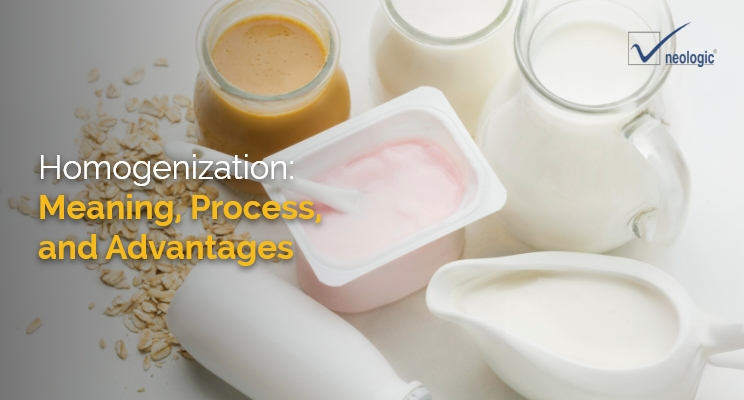
Homogenization: Meaning, Process, and Advantages
Homogenization is a mechanical process widely used in the food and dairy industries to create a uniform and stable product. It involves reducing the size of particles, such as fat globules in milk, and dispersing them evenly throughout a liquid. This process ensures that products like milk, cream, and peanut butter maintain a consistent texture and appearance, preventing separation of components. In this blog, we’ll explore the homogenization process, its applications, and benefits surrounding its impact on health and digestibility.
What is Homogenization
Homogenization is the process of breaking down large particles and distributing them uniformly in a liquid medium. Homogenization is a purely physical process that involves forcing a liquid through tiny openings under high pressure. This action fragments the fat globules, preventing them from clumping together and rising to the surface as cream.
Importantly, homogenization does not involve adding or removing any components from the milk, preserving its nutritional content. It is typically performed on pasteurized milk, as raw milk cannot be homogenized due to an enzyme that causes rancidity under pressure.
Why is Milk Homogenized?
In milk production, homogenization is performed using high-pressure pumps equipped with specialized valves. Hot milk, with its fat in a liquid state, is forced through these valves, reducing fat globule size from up to 18 micrometers to less than 2 micrometers. The smaller globules are then coated with a membrane of lipids, proteins, and casein micelles, forming a stable emulsion that keeps the fat evenly dispersed.
Here are the key reasons why milk is homogenized:
- Improved texture and appearance
- Enhanced flavor
- Longer shelf life
- Better cooking properties
- Easy for digestion
Advantages of Homogenization
The benefits of homogenization for milk include providing improved body and texture in ice cream as well as numerous other products, such as half-and-half, cream cheese, and evaporated milk. Homogenization offers numerous benefits that enhance the quality and usability of dairy products:
- No Cream Separation: Smaller fat globules prevent the formation of a cream layer, ensuring a uniform product.
- Whiter Color: Homogenized milk has a more appetizing, bright white appearance.
- Improved Flavor and Mouthfeel: The even distribution of fat creates a richer taste and smoother texture.
- Reduced Fat Oxidation: Homogenized milk is less prone to spoilage caused by fat oxidation.
- Better for Cultured Products: It enhances the stability of products like yogurt and cultured milk.
- Easier Digestion: The softer curds formed by smaller fat globules are more digestible.
While the benefits are significant, homogenization also has some drawbacks:
- Increased Production Costs: The equipment and energy required for homogenization add to manufacturing expenses.
- Sensitivity to Light: Homogenized milk is more susceptible to flavor defects like rancidity when exposed to light.
- Unsuitability for Certain Cheeses: The softer coagulum formed in homogenized milk can complicate the production of semi-hard or hard cheeses, making dewatering difficult.
- Raw Milk Incompatibility: Homogenizing raw milk leads to rapid flavor deterioration due to lipase activity.
Application of Homogenizers Beyond Milk
While milk is the most common product associated with homogenization, the process is also critical in producing other food and non-food items, including:
- Cream and Dairy Products: Homogenization improves the body and texture of ice cream, half-and-half, cream cheese, and evaporated milk.
- Peanut Butter: It creates a stable emulsion, preventing oil separation.
- Cosmetics and Pharmaceuticals: Homogenization ensures uniform distribution of ingredients in creams, lotions, and certain medications.
Homogenization and Health: Separating Myths from Reality
There are unfounded beliefs about milk homogenization which speculate that changes to milk particles would have adverse health effects. However, no good quality scientific evidence supports these beliefs. Unlike pasteurized and homogenized milk, raw milk (i.e., unpasteurized and, therefore non-homogenized) would create significant risks of serious illness due to the presence of pathogenic bacteria.
Homogenization is used to standardize and disperse milk fat globules to improve the texture, appearance and taste of milk. During homogenization, milk is subjected to high pressure, but nothing is added or removed from the milk. Despite the fact that the milk preserves its nutritional value, some wonder about the impact of this process on milk digestibility and health.
In Conclusion, Homogenization is a cornerstone of modern dairy production, transforming milk into a consistent, appealing, and versatile product. By breaking down fat globules and dispersing them evenly, homogenization enhances texture, flavor, and shelf life while making milk easier to digest. Despite myths about its health impacts, scientific evidence supports the safety and benefits of homogenized milk, with no significant adverse effects on nutrition or digestibility. From ice cream to cosmetics, homogenization plays a vital role in creating stable, high-quality products that meet consumer expectations.